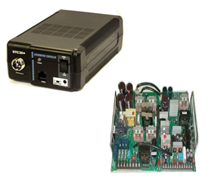
Selecting the proper electric screwdriver for a fastening application can be a daunting task at times. So many options and features being offered in the torque tool market today. Understanding the technology and educating yourself about the various differences among the electric screwdriver technology is the important element in order to properly evaluate a tool that will best fit your assembly application.
Electric screwdrivers that utilize a separate transformer (power supply) are designed for precision torque control and increasing production. The power supply may look like a simple little box that an electric torque screwdriver plugs into, but in recent years new technologies and innovative features have been added to these power supplies.
Internally, there are two different types of design technologies that are used for a transformer. There is the old technology, a coil designed power supply. The modern technology that is becoming more commonly used in a transformer is SMPS (switched-mode power supply).
Coil Power Supply (Linear Power Supply) is relatively a simple design that is not energy efficient and can provide an unstable voltage output to the electric screwdriver, which can affect the repeatability of the torque tool. The coil designed power supply can also shorten the life cycle of an electric screwdriver and increase the maintenance frequency for a power tool. Another added expense to deal with down the road. Commonly, a power supply that uses the coil technology is large, bulky and heavy because the unit has large mains-frequency transformers and heat-sinked electronic regulation circuitry inside the housing.
A switched-mode power supply (SMPS) is an electronic power supply that incorporates a switching regulator to convert electrical power efficiently. Unlike a linear power supply (Coil Power Supply), the SMPS uses a pass transistor that continually switches between low-dissipation, full-on and full-off states, and spends very little time in the high dissipation transitions, which minimizes wasted energy. An environmentally friendly power supply.
With the SMPS, voltage regulation is achieved by varying the ratio of on-to-off time. In contrast, a linear power supply regulates the output voltage by continually dissipating power in the pass transistor. The higher power conversion efficiency with the SMPS is a key technological advantage over the linear power supply technology. A power supply that uses the SMPS technology is usually lighter and smaller because the unit has smaller transformer inside the housing.
Understanding the different technologies used in the design of a power supply is important when purchasing a transformer to operate with an electric screwdriver. Use some caution when an industrial supplier is offering a “free” transformer with a purchase of selected type of electric screwdriver. What technology is the supplier really offering with a free power supply? Is it reliable and provide quality? Why is it being offered for free? Is the supplier offering a low quality solution for an easy, quick sale from their side? What are you willing to sacrifice with this incentive? A low cost tool is a short term solution. It becomes a long term, nagging costly expense that impacts quality and reputation.
When selecting a power supply to operate an electric screwdriver, a durable and reliable solution is worth the investment to ensure quality and safety. A unit that offers over heat protection (OHP) and over current protection (OCP) protects the electric screwdriver from damage or malfunction, and helps extend the life cycle of the tool.
New technologies and innovation have been added to power supplies, making these little boxes more versatile. Some transformers offer the ability to connect to a screw counter or provide “start & stop signal output” for a PLC. The STC30 Plus is a power supply that features a selectable “soft start” mode for applications that require the power tool to slowly ramp-up to its operating speed, which is perfect for plastic or sensitive assembly applications.
Using a quality power supply and electric screwdriver makes a safer world through accuracy and precision. Controlling torque is essential for companies to ensure their product’s quality, safety and reliability isn’t compromised. The failure of a three-cent fastener that isn’t properly tightened can lead to catastrophic or latent failures. Fasteners that are insufficiently fastened can vibrate loose and excessive torque can strip threaded fasteners.